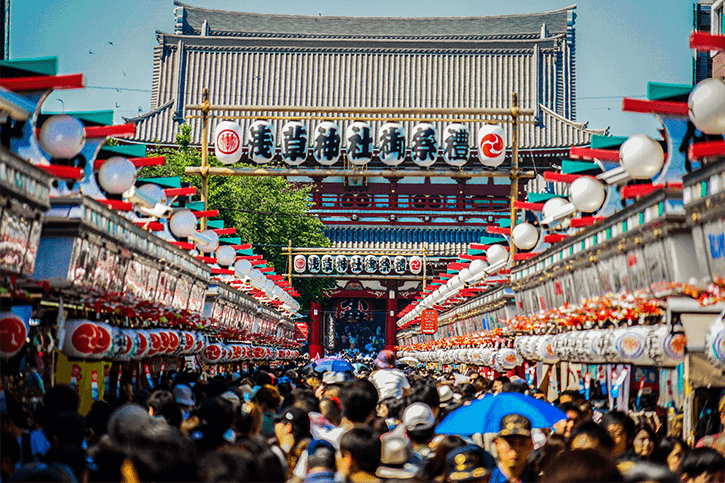
For centuries, Tokyoites have celebrated Asakusa, the spiritual heart of the city, with a boisterous, colorful party known as Sanja Matsuri. Sanja is among the most beloved, energetic and eye-popping of Japan’s traditional festivals, and 2023 marks its full-fledged return after four years of scaled-down events during the coronavirus pandemic.
-
01
The great foundation story
One of the three great festivals of Tokyo along with the Kanda Matsuri and Sanno Matsuri, Sanja Matsuri is decidedly the most popular party in the capital, drawing up to 2 million people over its three-day run. Sanja has it all: revelers in traditional happi jackets, headbands and loincloths, 100 mikoshi bouncing up and down on the shoulders of partiers, elegant geisha in dazzling kimono, and even yakuza gangsters showing off their full-body tattoos. In many ways its traditions, art forms, food and fun capture the atmosphere of Asakusa, a centuries-old entertainment district along the Sumida River. Everyone is welcome to take part in the fun.
![A Shinto priest performs a blessing ceremony at Asakusa Shrine, home of the Sanja Matsuri.]()
A Shinto priest performs a blessing ceremony at Asakusa Shrine, home of the Sanja Matsuri.
Because it’s held in Asakusa, Sanja Matsuri is associated with Sensoji Temple, the great Buddhist sanctuary founded in the 7th century AD as Tokyo’s oldest temple. Actually, Sanja is the annual festival of Asakusa Shrine, an often-overlooked Shinto Shrine adjacent to, but smaller than, Sensoji. The shrine and the Sanja Matsuri are both dedicated to the three men who founded Sensoji itself. According to legend, brothers Hinokuma Hamanari and Hinokuma Takenari were fishing in the Sumida River in 628 when their net pulled up a golden statue of Kannon, the Buddhist goddess of mercy. Hajino Nakatomo, a local landlord, persuaded the brothers to convert to Buddhism and the three consecrated the statue in a small temple that grew into Sensoji.
While the festival itself had precursors from as far back as the 7th century, it was formalized with the construction of a commemorative shrine. In the Edo period (1603–1867), the Shogun Tokugawa Iemitsu commissioned the construction of Asakusa Shrine to honor the three men as kami deities. The name “Sanja” literally means “three shrines” in reference to this trinity. In Edo times, the festival was held during the third lunar month on the old calendar, but since the Meiji period (1868–1912), it has been held on the weekend closest to May 17 and 18. -
02
With mikoshi, dancing in the streets
![Up to 2 million people partake in the Sanja Matsuri, where portable shrines are paraded through the neighborhood. Image courtesy Taito City.]()
Up to 2 million people partake in the Sanja Matsuri, where portable shrines are paraded through the neighborhood. Image courtesy Taito City.
Starting on Friday and lasting through Sunday, Sanja is a three-day religious celebration of boisterous merrymaking, musical performances, eating and drinking. Mikoshi containing the spirits of kami from neighborhood shrines are paraded through the streets to bring good fortune to locals and businesses. The mikoshi bearers are often accompanied by wagons of musicians playing flutes, taiko drums and other traditional percussion instruments, as well as cheerleaders with whistles who stoke the crowds into a fervor.
On Friday afternoon, the Daigyoretsu Parade proceeds from the streets behind Sensoji toward the front of the temple and up its main approach, Nakamise-dori. You can see dancers, musicians, geisha and priests decked out in Edo period attire, all very Instagrammable. The parade is followed by a Shinto ceremony and a traditional harvest dance. Next, mikoshi from local shrines are placed on heavy beams and shouldered through the streets around Sensoji.
Some 100 mikoshi from the 44 districts of Aasakusa take to the streets on Saturday, when groups of men, women and children, all in traditional festival attire, carry their portable shrines to Sensoji and Asakusa Shrine for blessings. They are then carried back to their neighborhoods to spread good fortune. Some mikoshi are carried exclusively by women and children.![The three main mikoshi of Asakusa Shrine weigh one ton each and are carried on heavy beams.
Image courtesy Taito City.]()
The three main mikoshi of Asakusa Shrine weigh one ton each and are carried on heavy beams. Image courtesy Taito City.
As part of the grand finale of the festival, the three main mikoshi from Asakusa Shrine appear from around 6:30 am on Sunday. These are especially enormous, elaborate, lacquered, gold-leaf affairs that cost some ¥40 million ($268,000) and weigh one ton; about 40 people are needed to carry each. In 2022, the three main mikoshi were placed on wheeled platforms to reduce the number of bearers amid coronavirus restrictions. But they were back on the shoulders of revelers in 2023. Rival teams jostle to carry the shrines, bouncing them up and down to enhance the power of the kami and spread good luck. They make their way through the streets, returning to Asakusa Shrine around 8 pm.
With thousands of revelers vying to carry the mikoshi by the main hall of Sensoji, the area is off-limits to visitors for safety reasons. You can still see the mikoshi on the outskirts of the temple, however, or take in other attractions. For instance, geisha give ticked dance performances on Saturday and Sunday at the Asakusa Kenban, and the Nihon Taiko Dojo academy puts on a drumming show at Asakusa Shrine. There’s also a large collection of food stalls on the west side of Sensoji where you can indulge in everything from deep-fried octopus to chocolate-covered bananas. At Tokyo’s biggest party, there’s really something for everyone.
Asakusa’s Sanja Matsuri is held from the Friday of the third weekend in May. For more information, see the Asakusa Shrine website https://www.asakusajinja.jp/en/sanjamatsuri/- Senso-ji Temple
-
-
- Tokyo Taito-ku Asakusa 2-3-1
-
-
-
- 0338420181
-
-
-
- [Main hall opening hours] 6:…
-
View AllAsakusa: 1400-year history exploration
¥13,000
Update date:2024/04/29
Super Hotel Asakusa
2-33-1 Asakusa, Taito-ku Tokyo





 Go here
Go here










